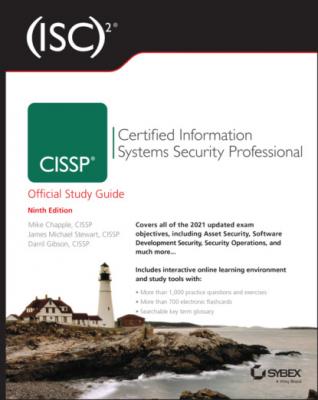(ISC)2 CISSP Certified Information Systems Security Professional Official Study Guide. Mike Chapple
Чтение книги онлайн.
Читать онлайн книгу (ISC)2 CISSP Certified Information Systems Security Professional Official Study Guide - Mike Chapple страница 61

At this point, the risk management process shifts from risk assessment to risk response. Risk assessment is used to identify the risks and set criticality priorities, and then risk response is used to determine the best defense for each identified risk.
Risk Responses
Whether a quantitative or qualitative risk assessment was performed, there are many elements of risk response that apply equally to both approaches. Once the risk analysis is complete, management must address each specific risk. There are several possible responses to risk:
Mitigation or reduction
Assignment or transfer
Deterrence
Avoidance
Acceptance
Reject or ignore
These risk responses are all related to an organization's risk appetite and risk tolerance. Risk appetite is the total amount of risk that an organization is willing to shoulder in aggregate across all assets. Risk capacity is the level of risk an organization is able to shoulder. An organization's desired risk appetite may be greater than its actual capacity. Risk tolerance is the amount or level of risk that an organization will accept per individual asset-threat pair. This is often related to a risk target, which is the preferred level of risk for a specific asset-threat pairing. A risk limit is the maximum level of risk above the risk target that will be tolerated before further risk management actions are taken.
You need to know the following information about the possible risk responses:
Risk Mitigation Reducing risk, or risk mitigation, is the implementation of safeguards, security controls, and countermeasures to reduce and/or eliminate vulnerabilities or block threats. Deploying encryption and using firewalls are common examples of risk mitigation or reduction. Elimination of an individual risk can sometimes be achieved, but typically some risk remains even after mitigation or reduction efforts.
Risk Assignment Assigning risk or transferring risk is the placement of the responsibility of loss due to a risk onto another entity or organization. Purchasing cybersecurity or traditional insurance and outsourcing are common forms of assigning or transferring risk. Also known as assignment of risk and transference of risk.
Risk Deterrence Risk deterrence is the process of implementing deterrents to would-be violators of security and policy. The goal is to convince a threat agent not to attack. Some examples include implementing auditing, security cameras, and warning banners; using security guards; and making it known that the organization is willing to cooperate with authorities and prosecute those who participate in cybercrime.
Risk Avoidance Risk avoidance is the process of selecting alternate options or activities that have less associated risk than the default, common, expedient, or cheap option. For example, choosing to fly to a destination instead of driving to it is a form of risk avoidance. Another example is to locate a business in Arizona instead of Florida to avoid hurricanes. The risk is avoided by eliminating the risk cause. A business leader terminating a business endeavor because it does not align with organizational objectives and that has a high risk versus reward ratio is also an example of risk avoidance.
Risk Acceptance Accepting risk, or acceptance of risk, is the result after a cost/benefit analysis shows countermeasure costs would outweigh the possible cost of loss due to a risk. It also means that management has agreed to accept the consequences and the loss if the risk is realized. In most cases, accepting risk requires a clearly written statement that indicates why a safeguard was not implemented, who is responsible for the decision, and who will be responsible for the loss if the risk is realized, usually in the form of a document signed by senior management.
Risk Rejection An unacceptable possible response to risk is to reject risk or ignore risk. Denying that a risk exists and hoping that it will never be realized are not valid or prudent due care/due diligence responses to risk. Rejecting or ignoring risk may be considered negligence in court.
Legal and in Compliance
Every organization needs to verify that its operations and policies are legal and in compliance with their stated security policies, industry obligations, contracts, and regulations. Auditing is necessary for compliance testing, also called compliance checking. Verification that a system complies with laws, regulations, baselines, guidelines, standards, best practices, contracts, and policies is an important part of maintaining security in any environment. Compliance testing ensures that all necessary and required elements of a security solution are properly deployed and functioning as expected. These are all important considerations when selecting risk response strategies.
Inherent risk is the level of natural, native, or default risk that exists in an environment, system, or product prior to any risk management efforts being performed. Inherent risk can exist due to the supply chain, developer operations, design and architecture of a system, or the knowledge and skill base of an organization. Inherent risk is also known as initial risk or starting risk. This is the risk that is identified by the risk assessment process.
Once safeguards, security controls, and countermeasures are implemented, the risk that remains is known as residual risk. Residual risk consists of threats to specific assets against which upper management chooses not to implement a response. In other words, residual risk is the risk that management has chosen to accept rather than mitigate. In most cases, the presence of residual risk indicates that the cost/benefit analysis showed that the available safeguards were not cost-effective deterrents.
Total risk is the amount of risk an organization would face if no safeguards were implemented. A conceptual formula for total risk is as follows:
threats * vulnerabilities * asset value = total risk
The difference between total risk and residual risk is known as the controls gap. The controls gap is the amount of risk that is reduced by implementing safeguards. A conceptual formula for residual risk is as follows:
total